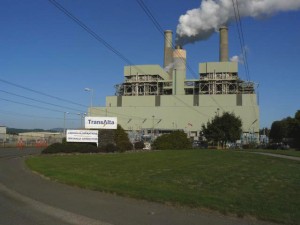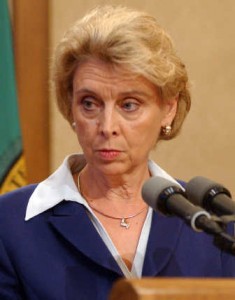
This weekend, Alberta-based utility company TransAlta, Washington Governor Christine Gregoire, and a coalition of environmental groups announced an agreement had been reached to stop burning coal at the Centralia power plant.
The Centralia plant is the largest single source of greenhouse gas emissions in Washington, responsible for 10% of the state’s emissions. It puts out as much pollution as 1.75 million cars.
The plan is to begin the phase-out in 2020 with the closing of the first burner and finish in 2025 with the closing of the second burner (yeah, I know it’s a long timeline).
It sounds like almost a done deal. But is it?
Currently, there are at least four more procedural stages before this proposed legislation becomes law.
Sunday’s Seattle Times reported: “Saturday’s agreement requires legislative approval, and the state Senate on Saturday passed a bill supporting the agreement 36 to 13. A House vote has not yet been scheduled, but a coalition of environmentalists, labor, Democrats and Republicans supports it.”
That’s a still a long haul for this plant to go to get on the books. There are lots of factors on all sides of the debate that could still stop the deal in its tracks. But we also need to remember that we’re still pretty far from a “Coal Free Northwest.”
Maybe I’m a purist, but when I hear “coal free” I think it means FREE from ALL coal.
This includes:
- No coal burning in the region whatsoever, preferably as quickly as possible.
- No coal exports through Longview, Bellingham and whatever other deepwater port Big Coal is scheming to buy.
- No coal-power imports from places like Puget Sound Energy’s coal plant in Colstrip, MT and the Jim Bridger, Wyodak, and Dave Johnston coal plants in Wyoming (none of which are affected by this legislation.)

One of Gov. Gregoire’s top aides, Keith Phillips, made the point that the governor thinks carbon reduction begins at home: “[W]hen the governor goes to Copenhagen or China and starts talking about our accomplishments, they take notice. The governor knows that reducing emissions starts at home.”
Of course that doesn’t make a lot of sense as Big Coal and the state of Washington are looking to become an export zone to Asian markets for Montana and Wyoming coal. But, according to Phillips, coal exports aren’t about climate change anyway, coal exports are about the hottest of hot button issues — JOBS: “The issues aren’t linked in the governor’s mind. I do know that some people see it as exporting U.S. coal to China so they can burn it and bake the planet. But other people see it as a source of port jobs.”
So when the governor’s office says reducing emissions begins at home, he means it begins at home unless its coal exported through Washington ports bound for China, Japan, South Korea and India. Phillips is also leaving out critical information about how Washington imports much of its coal-fired power from coal plants in Montana and Wyoming.
If we look at the entire coal-addicted picture, this legislation making Washington coal free is still pretty far from done. Montana and Wyoming, like Appalachia, are resource colonies for the dirty energy doomsday economy. Washington is quickly headed down the path of turning itself into a co-dependent for that doomsday economy.